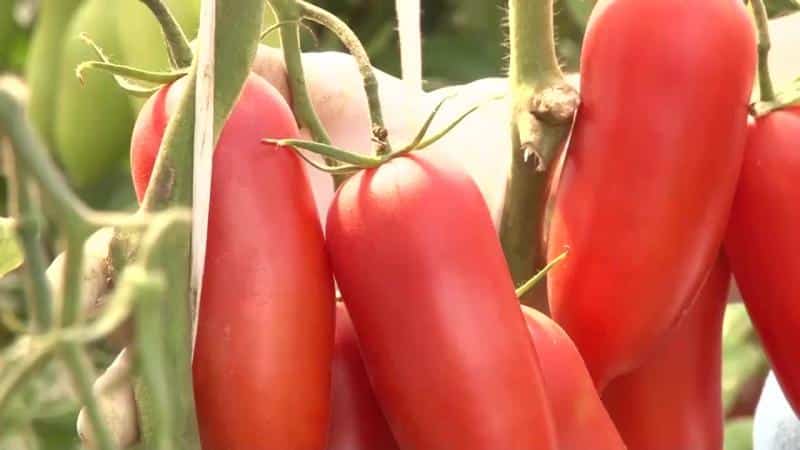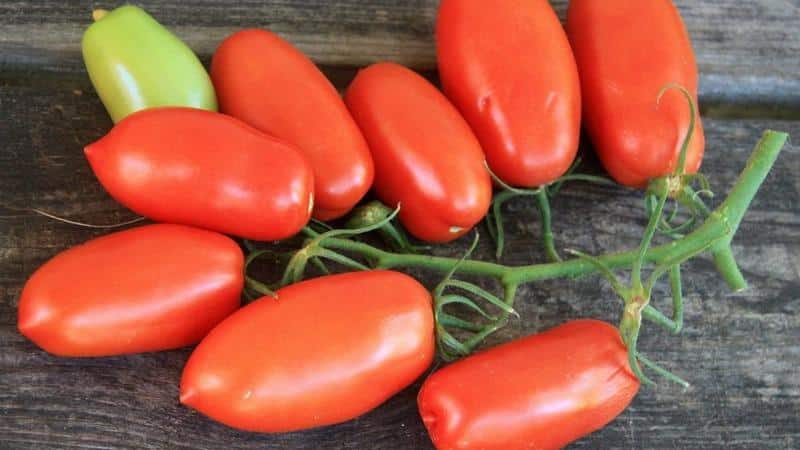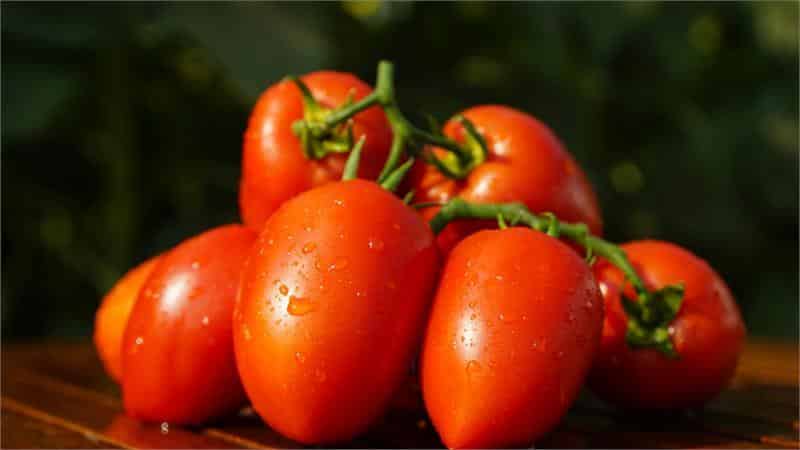Treats from the garden for real gourmets: tomato “Royal Temptation”
Adaptation to local climatic conditions, high-quality and abundant fruiting, resistance - these are, perhaps, the main conditions that gardeners follow when planting any crop on their plot.
Today we will talk about a tomato called Royal Temptation F1. This species was introduced into the range of the Partner agricultural company by breeder Nikolai Petrovich Fursov. The article will reveal all the secrets: from characteristics and care to farm reviews and photos of royal culture.
Tomato Temptation: characteristics and description of the variety
This is an early ripening hybrid with pepper-shaped fruits. Culture belongs to the category indeterminate, therefore its height is not limited: from average height to several meters in height. Resistant to many diseases and pests, in particular, to the tomato mosaic virus, fusarium, nematode.
The first inflorescence is formed above the 7-8 leaf, and 7 fruits ripen in the cluster. Both fresh and canned tomatoes are eaten. The hybrid is considered the most productive among others tomato varieties: up to 20 kg of fruits are collected from 1 sq. m. But this is not the limit: knowledge of agricultural technology will increase the amount of harvest. Ripening occurs in 100-105 days.
This vegetable crop is distinguished by its taste and commercial qualities. It also has good transportability.
How to grow seedlings
Growing seedlings is an important stage in the life of any plant. At this time, its health and ability to bear fruit are established.Therefore, it is so important to sow the seeds correctly and create favorable conditions for the plant.
Preparation
To obtain high-quality seedlings, seeds are treated with a 1% solution of potassium permanganate by immersing them in a glass jar for 20 minutes. After this, they are thoroughly washed and dried.
To stimulate growth, it is recommended to treat seeds with a product such as Immunocytophyte. After processing, the seeds are dried.
Important! There is no need to wash the seeds after using growth stimulants.

Container and soil
Seedlings are grown in wooden boxes or peat pots, and the latter are convenient because when planting in the soil there is no need to free the root system - they are planted in the ground directly in the pot. Plastic glasses are also convenient for these purposes: Before planting, they are carefully cut, the earthen lump remains unharmed. Wooden boxes are the cheapest to use, but it is worth remembering that in this case the process of planting seedlings will require a little more work and patience.
The soil mixture is prepared as follows: 2 parts of peat are mixed with 1 part of soil (from the garden), 1 part of sand and 0.5 part of humus. The resulting mixture is disinfected 10 days before use.
Sowing
In separate containers filled with prepared soil, 2-3 seeds are sown at a distance of at least 2 cm from each other.
When sowing in boxes, grooves of 4 cm are made, where seeds are placed at the same distance as in containers.
Seedlings of early hybrids are planted in the greenhouse in the second decade of April. Therefore, seeds are sown in early March. Shoots appear within a week after sowing. The plant blooms 55-60 days after planting the seeds.
Growing and care
During the first week, containers sown with seeds are covered with film at a room temperature of at least 25 ºС. At the first shoots, the film is removed and the temperature drops to 18 ºС. The containers are placed on the window to eliminate the lack of sunlight. Fluorescent lamps are suitable for additional lighting, since the daylight hours for seedlings should be at least 12 hours.
At first, the soil is not watered; spraying with a spray bottle is sufficient. For this purpose, boiled or settled water is used, with a temperature of at least 20 ºС.
After full-fledged leaves appear, watering begins at the root. 10 days after this, light fertilizing is added to the watering using complex fertilizers with a high nitrogen content. This fertilizer is prepared from potassium salt (1.5 g), urea (0.5 g), superphosphate (4 g), dissolved in 1 liter of water. Watering should be done twice a week.
How to grow tomatoes
To grow the Tsarskoe Temptation variety, the seedlings must be hardened off. A week after germination, the temperature is regularly reduced: during the day to 18ºC, and at night to 13ºC. In addition, hardening is performed by ventilating the room.
Landing
Planting seedlings in open ground occurs at a soil temperature of at least 15 ºС and an air temperature of at least 20 ºС.
Seedlings are planted in the greenhouse from mid-April, but the final date is determined by the appearance of the plant: height - at least 20 cm, number of leaves - at least 7, thickness - at least 5 cm.

Care
Taking care of this vegetable crop is a guarantee of qualitative and quantitative results. This variety, despite its royal name, is unpretentious to weather conditions and care during growth and development.But nevertheless, the plant will not be able to grow on its own without outside help.
Watering
First of all, the frequency of watering depends on precipitation. In the absence of rain, the plant is watered once a week, fed every 2 weeks with a mixture whose composition is as follows: ammonium nitrate (15 g), superphosphate (50 g), potassium chloride (40 g) per 10 liters of water. It is also recommended to feed with magnesium once every 2 weeks, and when the first flowers appear, add boron.
Stepsoning
Produced to increase the yield of the bush. In the southern regions, 2 shoots are left - the ovary will have time to ripen during a long warm period. In the northern ones, only one, central, shoot is left. Otherwise, the first frosts will occur before ripening.
The pinching procedure is carried out in the morning.
Important! It is impossible to plant crops in damp and cool weather, as infection can enter the plant through wounds.
Tomato bushes need regular weeding and loosening. Loosen the soil after each watering. In order for moisture to remain in the soil longer, it is subjected to mulching. Straw or sawdust is used as mulch.
A garter is also necessary, otherwise, under the weight of its own fruits, it will completely lie on the ground. Usually, a support (for example, a wooden stake) is installed next to the bush, to which the top of the plant is tied.
For preventive treatment, systemic-contact fungicides are used: Ditan M-45, Quadris 250. Vegetable crops are sprayed once every 20 days.
The nuances of growing in open ground and in a greenhouse
Seedlings are planted in a greenhouse earlier than in open ground. Agrotechnical care both in the greenhouse and outside is simple and consists mainly of watering.Do not forget that tomatoes do not like either drought or waterlogging.
Harvesting and application
The variety is ready to produce a harvest within 100 days after planting. The fruits are medium-sized, up to 130 g, and have few seeds. The taste is excellent, capable of satisfying any gourmet. They are consumed both fresh and in the form of canned preparations.
Advantages and disadvantages of the variety
Like any other crop, the Royal Temptation f1 tomatoes have both advantages and disadvantages. Benefits include:
- early and rapid ripening;
- fruit fleshiness;
- resistance of the variety to major diseases;
- high productivity;
- excellent taste and presentation.
Several disadvantages of this royal species:
- requires a garter;
- overripe fruits crack;
- does not differ in productivity in the north of the country;
- Growing in the shade leads to a deterioration in taste characteristics.

Farmer reviews
There are so many favorable reviews from farmers that all doubts about choosing a tomato variety disappear. Even those who grew this species for the first time are delighted. They are especially noted for their disease resistance and excellent taste. Many of the farmers touchingly call this crop “my love.”
Lyudmila, Saratov: “I took the seeds of the Royal Temptation from a neighbor. I don’t really like newfangled hybrids, but this time I decided to make an exception. And I was not mistaken! I and the whole family liked the large, moderately sweet tomatoes. No special care is required."
Conclusion
The variety will be appreciated by both beginners in farming and experienced gardeners. Equally important is its ability to adapt to life in any region, despite the many nuances of weather conditions.Also impressive is the correspondence between the appearance and the taste of the fruit: they are not only charmingly beautiful, but also tasty. Minimal expenditure of effort, time and money, ease of care, resistance and unpretentiousness - all this creates an irresistible temptation to try the variety on your site.